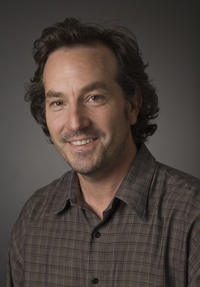Campus News
UCSC researchers contribute to detailed ovarian cancer analysis
A team of UCSC researchers contributed to an analysis of genomic changes in ovarian cancer that has provided the most comprehensive and integrated view of cancer genes to date. Their work focused on understanding the molecular pathways in the cell that are disrupted in ovarian cancer.


An analysis of genomic changes in ovarian cancer has provided the most comprehensive and integrated view of cancer genes for any cancer type to date. Ovarian serous adenocarcinoma tumors from 500 patients were examined by The Cancer Genome Atlas (TCGA) Research Network; the analyses are reported in the June 30 issue of Nature.
A team of UCSC researchers contributed to the analysis, led by David Haussler, distinguished professor of biomolecular engineering, and Josh Stuart, associate professor of biomolecular engineering in the Baskin School of Engineering. Their work focused on understanding the molecular pathways in the cell that are disrupted in ovarian cancer.
“A pathway is a collection of genes that talk to each other in the cell,” Haussler said. “Josh Stuart did the analysis to see whether certain pathways were characteristically disrupted in ovarian cancer, and he found one very strong pathway that is disrupted in advanced ovarian cancer.”
Most prevalent form
Serous adenocarcinoma is the most prevalent form of ovarian cancer, accounting for about 85 percent of all ovarian cancer deaths. TCGA researchers completed whole-exome sequencing, which examines the protein-coding regions of the genome, on an unprecedented 316 tumors. They also completed other genomic characterizations on these tumors and another 173 specimens.
“This landmark study is producing impressive insights into the biology of this type of cancer,” said NIH Director Francis Collins, M.D., Ph.D. “It will significantly empower the cancer research community to make additional discoveries that will help us treat women with this deadly disease. It also illustrates the power of what’s to come from our investment in TCGA.”
TCGA is jointly funded and managed by the National Cancer Institute (NCI) and the National Human Genome Research Institute (NHGRI), both part of the National Institutes of Health.
UCSC’s role
Haussler helped assemble the first working draft of the human genome and now leads efforts to use the information encoded in the genome sequence to transform the practice of medicine and our understanding of biology. He joined the UCSC faculty in 1986 and earned his B.A. in mathematics from Connecticut College, an M.S. in applied mathematics from California Polytechnic State University, San Luis Obispo, and a Ph.D. in computer science from the University of Colorado, Boulder.
Stuart joined the UC Santa Cruz faculty in 2003 and is affiliated with the Center for Biomolecular Science and Engineering headed by Haussler. He earned a B.S. in computer science and a B.A. in molecular, cell, and developmental biology from the University of Colorado, Boulder, and a Ph.D. in biomedical informatics form Stanford University. In 2006, the Alfred P. Sloan Foundation selected him as a Sloan Research fellow to support his research in developing computational tools for studying how genes work an identifying networks of genes involved in important biological functions.
Mutations in a single gene
Among the specific findings described in the Nature paper is the confirmation that mutations in a single gene, TP53, are present in more than 96 percent of all such cancers. TP53 encodes a tumor suppressor protein that normally prevents cancer formation. Mutations in the gene disrupt this protein’s function, which contributes to uncontrolled growth of ovarian cells. In addition, TCGA identified a multitude of less-frequent mutations in other genes.
TCGA researchers also established how sets of genes are expressed in a fashion that can predict patient survival— identifying patterns for 108 genes associated with poor survival and 85 genes associated with better survival. Patients whose tumors had a gene-expression signature associated with poor survival lived for a period that was 23 percent shorter than patients whose tumors did not have such a signature. The overall five-year survival rate for ovarian cancer is 31 percent, which means that 69 percent of patients diagnosed this year will not be alive in 2016, highlighting the urgent need for a better understanding of the disease.
“The new knowledge of the genomic changes in ovarian cancer has revealed that the molecular catalysts of this disease are not limited to small changes affecting individual genes,” said NCI Director Harold E. Varmus, M.D. “Also important are large structural changes that occur in these cancer genomes. Cancer researchers can use this comprehensive body of information to better understand the biology of ovarian cancer and improve the diagnosis and treatment of this dreaded disease.”
Sixty-eight genes targeted
To identify opportunities for targeted treatment, the investigators searched for existing drugs that might inhibit amplified or over-expressed genes that were suggested to play a role in ovarian cancer. The search identified 68 genes that could be targeted by existing Food and Drug Administration-approved or experimental therapeutic compounds. The investigators noted that one type of drug, a PARP (Poly ADP ribose polymerase) inhibitor, might be able to counteract the DNA repair gene observed in half of the ovarian tumors studied. While researchers have known that these drugs could be effective against the disease, this study revealed that 50 percent of tumors might be responsive to drugs that exploit the genetic instability of the tumors and induce the cancer cells to die.
“Like all cancers, ovarian cancer results from genomic derangements,” said Eric D. Green, M.D., Ph.D., NHGRI director. “The efforts of TCGA are confirming that the more we learn about genomic changes in tumor cells, the more we will be able to care for the people affected by cancer.”
The results of this study support the existence of four distinct subtypes of the disease, based on the patterns seen in the transcription of RNA from DNA. They also support the existence of four related subtypes based on the patterns of DNA methylation—a chemical reaction in which a small molecule called a methyl group is added to DNA, changing the activity of individual genes. These patterns likely reflect the functional changes associated with ovarian serous adenocarcinoma, but are not strongly associated with survival duration.
Increased risk
Mutations in BRCA1 and BRCA2 genes, which are associated with some forms of breast cancer, also confer increased risk for ovarian cancer. In this study, approximately 21 percent of the tumors showed mutations in these genes. Analysis of these tumors confirmed observations that patients with mutated BRCA1 and BRCA2 genes have better survival odds than patients without mutations in these genes.
Importantly, investigators identified that the mechanism by which the BRCA1 and BRCA2 genes become defective also relates to survival. If either of the BRCA1 and BRCA2 genes is mutated, there is improved survival duration. However, if BRCA1 activity is instead reduced by methylation, there is no improved survival duration.
“The integration of complex genomic data sets enabled us to discover an intricate array of genomic changes and validate one specific change that occurs in the vast majority of all ovarian cancers,” said lead author Paul T. Spellman, Ph.D., Lawrence Berkeley. “Significantly, we have also found new information regarding the role that the BRCA1 and BRCA2 genes play in determining survival.”
In this latest study, the TCGA researchers built upon the approach they used in 2008 to characterize the genome of gliobastoma multiforme, the most common form of brain cancer.
TCGA, launched in 2006, is a comprehensive and coordinated effort to accelerate the understanding of the molecular basis of cancer through the application of genome analysis technologies, including large-scale genome sequencing. TCGA data are being made rapidly available to the research community through a database, http://tcga-data.nci.nih.gov/tcga. The database provides direct access to most analytic datasets, with other data, such as patient treatment records and raw DNA sequence data, available to qualified researchers through an NIH review and approval process.
Future TCGA analyses of over 20 other tumor types will be primarily funded using American Recovery and Reinvestment Act (ARRA) monies.